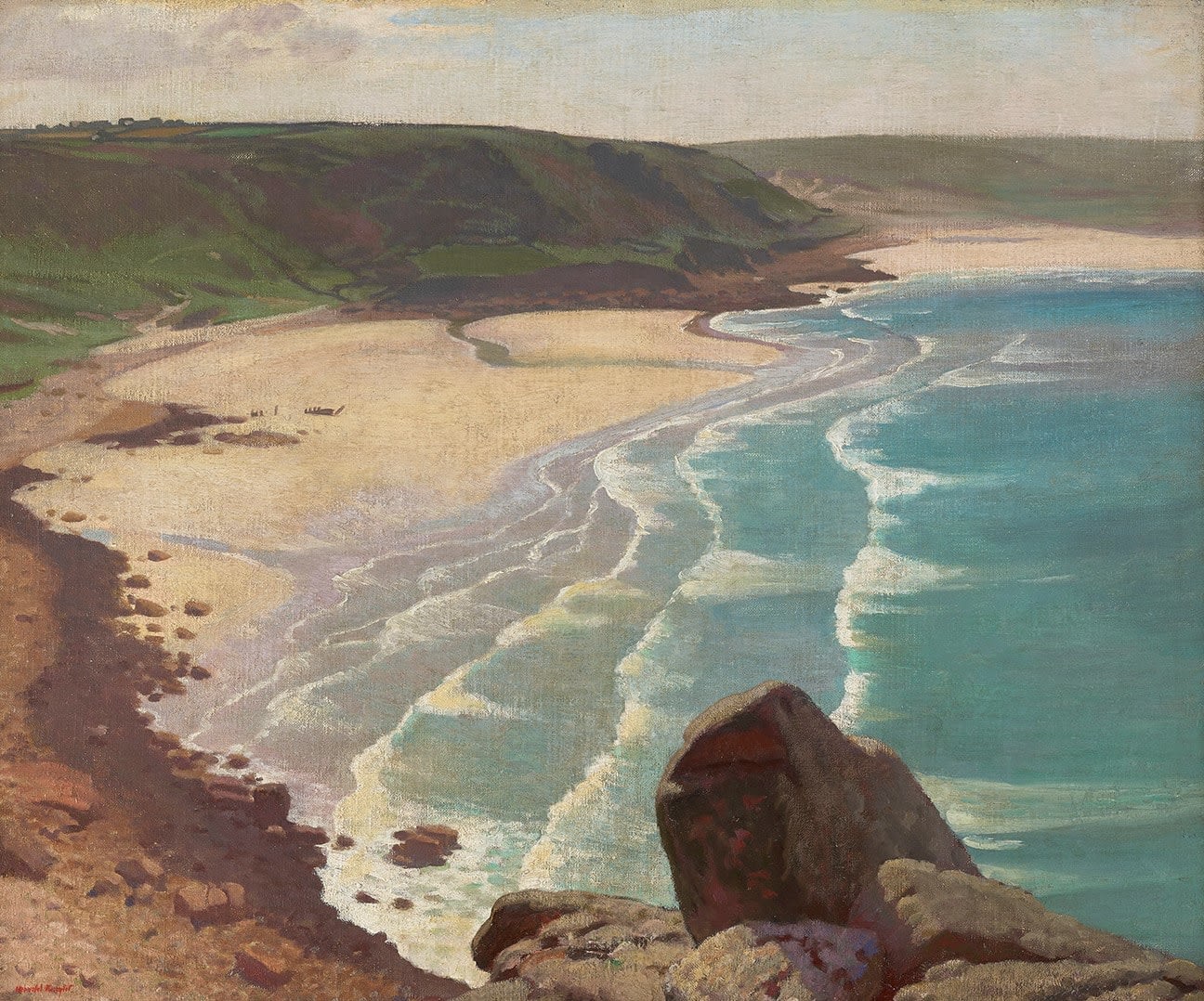
Harold Knight RA
Whitsand Bay, Cornwall
Oil on canvas
25 x 30 in (63.5 x 76.2 cm)
Philip Mould & Co.
To view all current artworks for sale visit philipmould.com Harold Knight, along with his wife Laura (née Johnson), was among the later arrivals to the Newlyn School of artists,...
To view all current artworks for sale visit philipmould.com
Harold Knight, along with his wife Laura (née Johnson), was among the later arrivals to the Newlyn School of artists, a group unified by their shared attraction to the natural light and economic living standards available to artists in Cornish fishing villages around the turn of the twentieth century. Arriving in Cornwall in 1907 from Staithes, North Yorkshire, following a prolonged sojourn in Paris, Harold and Laura became firmly entrenched within the Lamorna branch of the wider bohemian community of Cornish-based artists. They remained in Cornwall until 1919 painting continuously while steadily establishing their respective reputations.
Both Harold and Laura had been exhibiting their works at the Royal Academy ‘Summer Exhibition’ since 1905 and continued to do so consistently until the 1960s. Laura, undoubtedly the wider known artist today, secured the enviable accolade of becoming the first female artist to be elected to full membership of the Royal Academy in 1936, having already been honoured with a Damehood in 1929.
Though the output of Harold Knight was arguably overshadowed by that of his wife during his own lifetime, recent scholarship has come to reassess his valuable contribution to the broader, albeit flexible, genre of English Impressionism. His professional reputation during his own lifetime was temporarily hindered by his admirable resistance to the First World War as a conscientious objector. However, his artistic contribution to society did not waver and he went on to be awarded full membership of the Royal Academy in 1937, one year after Laura.
Knight produced many works during his time in Cornwall and continued to return to the area to paint en plein air in the manner of the European Impressionists following the couple’s move to London after the end of the war. It is likely that Knight produced the present work during one of these trips.
Whitsand Bay, situated in south east Cornwall, runs from Rame Head in the east to Portwrinckle in the west. The present landscape was most likely completed in situ with Knight setting up his easel outdoors, a method employed by John Constable, the Barbizon School and later popularised by the Impressionists. The present work shows the meandering coastline during the transient period between tides and is a characterful example of the artist’s landscapes imbued with a sense of natural rhythm and a subtle palette typical of the Cornish topography.
Harold Knight, along with his wife Laura (née Johnson), was among the later arrivals to the Newlyn School of artists, a group unified by their shared attraction to the natural light and economic living standards available to artists in Cornish fishing villages around the turn of the twentieth century. Arriving in Cornwall in 1907 from Staithes, North Yorkshire, following a prolonged sojourn in Paris, Harold and Laura became firmly entrenched within the Lamorna branch of the wider bohemian community of Cornish-based artists. They remained in Cornwall until 1919 painting continuously while steadily establishing their respective reputations.
Both Harold and Laura had been exhibiting their works at the Royal Academy ‘Summer Exhibition’ since 1905 and continued to do so consistently until the 1960s. Laura, undoubtedly the wider known artist today, secured the enviable accolade of becoming the first female artist to be elected to full membership of the Royal Academy in 1936, having already been honoured with a Damehood in 1929.
Though the output of Harold Knight was arguably overshadowed by that of his wife during his own lifetime, recent scholarship has come to reassess his valuable contribution to the broader, albeit flexible, genre of English Impressionism. His professional reputation during his own lifetime was temporarily hindered by his admirable resistance to the First World War as a conscientious objector. However, his artistic contribution to society did not waver and he went on to be awarded full membership of the Royal Academy in 1937, one year after Laura.
Knight produced many works during his time in Cornwall and continued to return to the area to paint en plein air in the manner of the European Impressionists following the couple’s move to London after the end of the war. It is likely that Knight produced the present work during one of these trips.
Whitsand Bay, situated in south east Cornwall, runs from Rame Head in the east to Portwrinckle in the west. The present landscape was most likely completed in situ with Knight setting up his easel outdoors, a method employed by John Constable, the Barbizon School and later popularised by the Impressionists. The present work shows the meandering coastline during the transient period between tides and is a characterful example of the artist’s landscapes imbued with a sense of natural rhythm and a subtle palette typical of the Cornish topography.
Provenance
Private Collection, UKThe Fine Art Society, London, April 1984, no. 5877.
Be the first to hear about our available artworks
* denotes required fields
We will process the personal data you have supplied in accordance with our privacy policy (available on request). You can unsubscribe or change your preferences at any time by clicking the link in our emails.